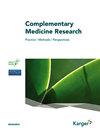益气活血中药联合达帕格列净治疗 2 型糖尿病合并心力衰竭:基于随机对照试验的系统评价和荟萃分析。
IF 0.8
4区 医学
Q3 INTEGRATIVE & COMPLEMENTARY MEDICINE
引用次数: 0
摘要
方法对益气活血中药联合达帕格列净治疗 2 型糖尿病(T2DM)合并心力衰竭(HF)的随机对照试验(RCT)进行了评估。检索时间跨度为数据库建立至 2023 年 6 月,包括 7 个数据库:中国知网(CNKI)、万方数据库、VIP数据库、PubMed、Embase、Cochrane图书馆和中国生物医学文献数据库。两名研究人员根据纳入和排除标准筛选和提取数据。结果共纳入 7 篇文章,样本量为 1192 例。荟萃分析结果表明,益气活血中药与达帕利洛嗪合用可提高临床有效率[OR=4.35,95% CI (2.98,6.35),P<0.00001]。它降低了血糖水平,表现为空腹血糖(FBG)降低[MD=-1.19,95% CI(-1.30,-1.09),P<0.00001],餐后 2 小时血糖(2hPG)降低[MD=-1.95,95% CI(-2.09,-1.80),P<0.00001]和糖化血红蛋白(HbA1c)[MD=-1.40,95% CI(-1.49,-1.31),P<0.00001]。炎症因子也有所降低,包括C反应蛋白(CRP)[MD=-4.93,95% CI(-5.38,-4.48),P<0.00001]、肿瘤坏死因子(TNF-α)[MD=-2.91,95% CI(-3.32,-2.49),P<0.00001]和白细胞介素-6(IL-6)[MD=-11.10,95% CI(-12.43,-9.43),P<0.00001]。此外,左心室舒张末期直径(LVEDD)[SMD=-1.25,95% CI(-1.45,-1.05),P<0.00001]、左心室收缩末期直径(LVESD)[SMD=-1.34,95% CI(-1.51,-1.13),P<0.00001]和左心室射血分数(LVEF)[SMD=2.92,95% CI (2.65,3.19),P<0.00001]、6分钟步行测试(6MWT)[MD=35.59,95% CI (29.72,41.47),P<0.00001]和明尼苏达心衰患者生活问卷(MLHFQ)评分[MD=35.59,95% CI (29.72,41.47),P<0.00001]均有所改善。结论益气活血中药与达帕利洛嗪联合治疗T2DM合并HF患者显示出潜力,建议在临床实践中作为辅助治疗使用。然而,由于纳入研究的数量和质量有限,有必要进一步开展高质量的研究来证实这些发现。本文章由计算机程序翻译,如有差异,请以英文原文为准。
Combination of Qi benefiting and blood circulation promoting herbs with Dapagliflozin in the treatment of type 2 diabetes mellitus combined with heart failure: a systematic evaluation and meta-analysis based on a randomized controlled trial.
INTRODUCTION
This systematic review examines the efficacy of a combination of Qi benefiting and blood circulation promoting herbs with Dapagliflozin in treating type 2 diabetes mellitus (T2DM) combined with heart failure (HF).
METHODS
Randomized controlled trials (RCTs) assessing the combination of Qi benefiting and blood circulation promoting herbs with Dapagliflozin for T2DM and CHF was conducted. The search, spanning from the database's establishment to June 2023, included seven databases: China Knowledge Network (CNKI), Wanfang Database, VIP Database, PubMed, Embase, Cochrane Library, and the Chinese Biomedical Literature Database. Two researchers screened and extracted data based on inclusion and exclusion criteria. The Cochrane Handbook version 5.1 guided the quality assessment of studies, and the meta-analysis was performed using RevMan 5.4 software.
RESULTS
Eleven articles, encompassing a sample size of 1192 cases, were included. Meta-analysis results indicated that combining Qi benefiting and blood circulation promoting herbs with Dapagliflozin improved the clinical efficacy rate [OR=4.35, 95% CI (2.98, 6.35), P<0.00001]. It reduced blood glucose levels, evidenced by decreased fasting blood glucose (FBG) [MD=-1.19, 95% CI (-1.30, -1.09), P<0.00001], 2-hour postprandial blood glucose (2hPG) [MD=-1.95, 95% CI (-2.09, -1.80), P<0.00001], and glycosylated haemoglobin (HbA1c) [MD=-1.40, 95% CI (-1.49, -1.31), P<0.00001]. Inflammatory factors also reduced, including C-reactive protein (CRP) [MD=-4.93, 95% CI (-5.38, -4.48), P<0.00001], tumor necrosis factor (TNF-α) [MD=-2.91, 95% CI (-3.32, -2.49), P<0.00001], and interleukin-6 (IL-6) [MD=-11.10, 95% CI (-12.43, -9.43), P<0.00001]. Additionally, left ventricular end-diastolic diameter (LVEDD) [SMD=-1.25, 95% CI (-1.45, -1.05), P<0.00001], left ventricular end-systolic diameter (LVESD) [SMD=-1.34, 95% CI (-1.51, -1.13), P<0.00001], and improved left ventricular ejection fraction (LVEF)[SMD=2.92, 95% CI (2.65, 3.19), P<0.00001], 6-minute walk test (6MWT) [MD=35.59, 95% CI (29.72, 41.47), P<0.00001], and Minnesota Living with Heart Failure Questionnaire (MLHFQ) scores [MD=35.59, 95% CI (29.72, 41.47), P<0.00001] were observed. The incidence of adverse events also decreased [RR=0.25, 95% CI (0.11, 0.56), P=0.0007].
CONCLUSION
The combination of Qi benefiting and blood circulation promoting herbs with Dapagliflozin shows potential in treating patients with T2DM and HF, suggesting its use as adjunctive therapy in clinical practice. However, the limited number and quality of the included studies necessitate further high-quality research to confirm these findings.
求助全文
通过发布文献求助,成功后即可免费获取论文全文。
去求助
来源期刊

Complementary Medicine Research
Medicine-Complementary and Alternative Medicine
CiteScore
2.90
自引率
5.60%
发文量
50
期刊介绍:
Aims and Scope
''Complementary Medicine Research'' is an international journal that aims to bridge the gap between conventional medicine and complementary/alternative medicine (CAM) on a sound scientific basis, promoting their mutual integration. Accordingly, experts of both conventional medicine and CAM medicine cooperate on the journal‘s editorial board, which accepts papers only after a rigorous peer-review process in order to maintain a high standard of scientific quality.
Spectrum of ''Complementary Medicine Research'':
- Review and Original Articles, Case Reports and Essays regarding complementary practice and methods
- Journal Club: Analysis and discussion of internationally published articles in complementary medicine
- Editorials of leading experts in complementary medicine
- Questions of complementary patient-centered care
- Education in complementary medicine
- Reports on important meetings and conferences
- Society Bulletins of Schweizerische Medizinische Gesellschaft für Phytotherapie (SMGP) and Deutsche Gesellschaft für Naturheilkunde
Bibliographic Details
Complementary Medicine Research
Journal Abbreviation: Complement Med Res
ISSN: 2504-2092 (Print)
e-ISSN: 2504-2106 (Online)
DOI: 10.1159/issn.2504-2092
www.karger.com/CMR
 求助内容:
求助内容: 应助结果提醒方式:
应助结果提醒方式:


